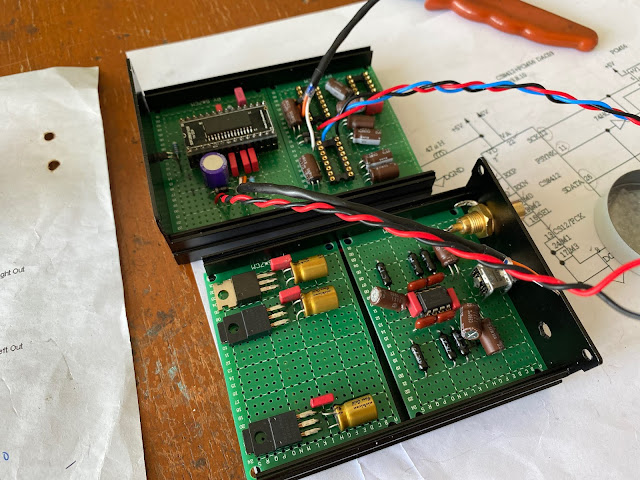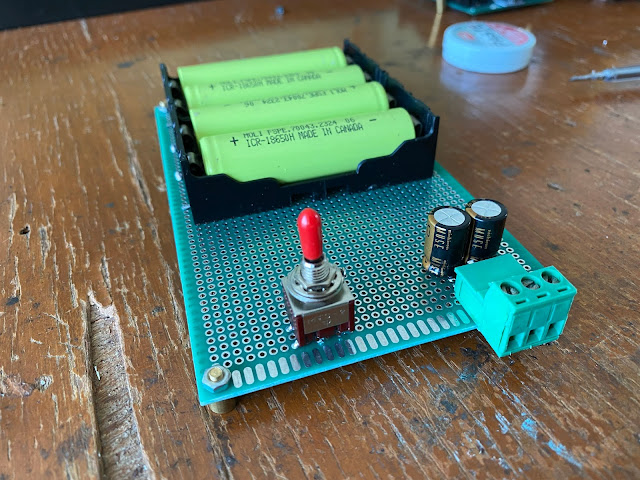From early this year, I am start to playing a lot with the multibit DAC.
They are from Sony CDP TDA1541A here, Nakamichi DAC-101 dual TDA1541S1 here, Clarion DRX-9255EXL PCM1702 here and Clarion HX-D1 PCM1704 here.
What I said playing with them is actually more suitable words because none of them are built by myself. I only study and exploring those unit then make some upgrade especially on the power supply components, signal capacitors upgrade, and bypassing the unused internal circuit for more clearer yet natural sound quality. This upgrade make a lot improvement compare to the first time I listen from it and I can really enjoy what the designer from each manufacture deliver the sound they would like to perform in those units.
Those said units are categorized as a parts of hi-end audio system and I really now familiar with the sound signature from each of them. But to be honest, I am not satisfy yet with this condition. Because none of them is built by myself from ground up. I don't feel like my own signature are on those unit. So, after searching the availability option for any R2R DAC IC out there, I stuck to this late 80's vintage DAC IC. This is the PCM56P.
Why PCM56? the short answer is this DAC is a designer dream. By looking to the datasheet, there no others DAC IC out there, especially for the R2R multibit DAC has very wide range of input voltage from 5 volt up to 12 volt. This PCM56 has internal voltage regulation and also an op-amp for I/V conversion or whatever you want to use to the op-amp anyway.
The internal resistors ladder network are laser trimmed using Ni-Cr or Ni-chrome resistor for precise value. Also there is a MSB adjustment for adjusting the THD as per datasheet stated, although this is not very necessary anyway.
One things need to consider about this PCM56 is only accept Left Justified serial input provided by CS8412 digital receiver IC.
I got reference schematic from this Japanese websites here.
I using CS8412 instead of DIR9001 as SPDIF digital receiver. The reason for using CS8412 in my opinion is still the simple yet best sounding digital receiver up to today. But of course it is limited up to 96Khz and I still love the red book audio files which they are 16 bit CD quality. The setting mode for this CS8412 is on mode-5 as per datasheet information L/R 16 bit LSBJ.
I am using the configuration from the schematic above especially for the right and left channel separation using hex inverter IC 74HC04.
The only issue with that schematic is not using any LPF circuit after the analog output from the DAC which in my opinion is a flaws for this kind DAC in order to get the pure audio signal without any high frequency digital noise.
So I design the LPF circuit which is the common one. Here is the schematic.
The main reason this LPF circuit exist is for cutting non audio frequency in 2nd order configuration. This is due to digital conversion inside the DAC chips that normally produce noises over 50kHz. The cutting frequency value for this LPF is actually around 40kHz with op-amp gain is 1. The LM4562NA op-amp in this circuit is for my personal preference only. All op-amps will do the same but sound quality may difference one to another.
Because this is the first time I am building the DAC using PCM56, then for more practical issue in order to test the section one by one, I separate this DAC into 4 sections. Each section is put into 5x7 cm PCB and all connection are point-to-point.
The first section is the SPDIF receiver board. The input output from this section is DC 5 volt, SPDIF input, and 16 bit LSBJ output
The second section is the DAC section consist of 2 pcs PCM56 and a 74HC04. The input output in this section is dual rail DC 5+ & 5- volt, 16 bit LSBJ input and audio output.
As you can see I put the diodes on each circuit above for protection just in case I accidentally put the voltage in reverse.
Then the next section which is the LPF section have input output is dual rail DC 5+ & 5- volt, signal audio input from DAC and analog line out.
The 4th circuit is the power supply regulator circuit using 7805 and 7905 for DAC and LPF circuit, also another 7805 for the receiver circuit and the 78HC04 hex inverter IC.
Then those 4 circuit above are connecting together before put inside an aluminum case. The case dimension is 10 cm x 7.5 cm x 3.5 cm.
Quite compact isn’t it.
It is a tight fit inside this tiny case but they are perfectly in place. You also notice there is a blue light in front of this DAC unit. This LED is for lock signal indicator taken from pin 28 CS8412 to 470 ohm resistor before goes to LED and positive 5 volt.
That is the final look for this PCM56 DAC before I close the box. The digital audio input is RCA SPDIF, the line out is through 3.5 mm mini socket and the power supply required anything dual rail voltage above 7 volt and less than 25 volt.
So to fulfilled this power needs, I build this using 4 pieces lithium batteries each 3.7 volt. Now I get dual voltage DC +7,4+ and -7,4 volt.
I put a toggle switch to power it ON and OFF. I also using pair of Nichicon Muse capacitor for sweetening my eyes when looking to this power supply board.
Technically by using 4 pieces 2000mAH 1860 lithium batteries, this DAC could operate more than 100 hours of playing time. This could be the longest DAC operating ever made on earth.
Most of the time, I will easily forget to re-charge the batteries when they are getting low, let's say bellow 3.4 volt for each batteries and they need to re-charge again. So I made simple low-batteries indicator using TL431 IC, several resistors and LED's. The schematic for this low batteries indicator circuit is widely available on the internet.
This is all the building process for this PCM56 non oversampling R2R DAC.
It is time to review the sound quality.
The condition of this DAC is all brand new, except all IC are used, dismantle from others unit. The first time I listen to this DAC is very promising. I like how the low frequency very extended. The solid bass come from the bass-guitar and the drums deliver with lots of energy and full of texture. I never listen any DAC that have this good resolution on the low frequency like this one. This PCM56 DAC will make you like the bass sound like never before.
I am going to the mid range which most musical instrument and vocal are presenting in this frequency range which is definitely deliver in full resolution. Once you are familiar with the sound from multibit DAC, then you know no other Delta Sigma DAC can compete in this range. It is so natural and so intimacy.
Compare this PCM56 to others DAC, the vocal is having position on the middle, not laid back as the PCM1702 or PCM1704 but also not in-your-face like the TDA1541. The vocal sound characteristic from this PCM56 is warm and smooth. I think it is very warm for my taste. Comparing to the TDA1541 which is the smoother sound among all multibit DAC I have reviewed. This PCM56 in my opinion is still presenting smooth sound characteristic.
Going to the high frequency, this PCM56 will not offer you rich and detail high frequency. I think this PCM56 is the shy on the high frequency compares to others like PCM1702, PCM1704 or even TDA1541. Then when I taking on the high frequency, easily related to detail and sound-stage. This PCM56 is just like a small studio sound compares to the crazy sound-stage like the PCM1702 and PCM1704. This PCM56 sound-stage will presenting narrow.
By comparing them side-by-side, you can tell that PCM1702 and PCM1704 are more advance than the PCM56. But is it? Experience may vary, taste also may be different one to another, but this PCM56 is also having a good sound stage that for me is still enjoyable.
Although this is still my on going project DAC, to be honest, I didn't expecting the result from this built could be this good. I need more time to listen the music from this DAC and let the capacitors to break-in first before I make another adjustment. But for now, I couldn't more happier than having this DAC working like a charms especially having the sound performance like this:)
Disclaimer: Any statement and photos in this article are not allowed to copy or publish without written permission from the writer. Any injury or loss from following tips in this article is not under writer responsibility.





























Curious. Did you listen to the PCM56 using internal voltage out vs. I/V?
ReplyDeleteI always using V out on my PCM56 built.
DeleteI had once using a resistor for IV on TDA1541 but somehow I prefer opamps based IV.
While hardwiring has it”s strong advantages in analog boards, it is quite bad idea when it comes to digital. You just cannot achieve proper digital grounding. Not mentioning wires between the filter and the dac boards. Yes, it will work, but for sure these wonderful dacs are far from their comfort zone. This will sound average at best.
ReplyDeleteCant say much if theory put up front, while all of my DAC built sound fantastic 😊
DeleteHi! You mentioned that TDA1541A was smoother than PCM56, but you also said TDA1541A vocal was very forward and in your face. Would you mind elaborating a bit as they seem conflicting. To me forward vocal means being shouty vocal, no ? Thanks.
ReplyDeleteHi there.
ReplyDeleteI tried to explain.
The TDA1541 have more foward vocal characteristic, means the soundstage created just like the singer in front of you with the instruments behind. It is different with smooth sounding. What I can describe with smoother sound is just like less distortion in every instruments play.
Hi there. Have you listened to PCM63PK ? I heard it is almost same as PCM1702, which you seem to like quite a lot. Thanks.
ReplyDeletePCM63 is become my first tier of vintage multibit DAC. The "K" grade is even better.
DeleteHi there. You mentioned PCM1702 vocal is laid back and not in your face. Is PCM63 similar in this regard ? Thanks!
DeleteHi Orronoco, will you please share the schematics of your PCM56 diy dac ? I have asced you that question in connection with the TDA1543 dac I am modding. My email niamex@gmail.com, Thanks in advance your cooperation,
ReplyDeleteIgnat